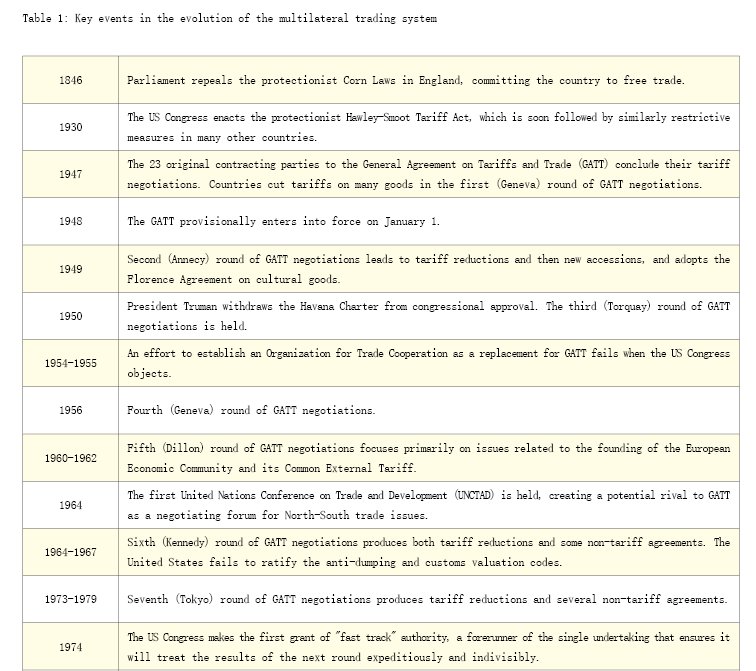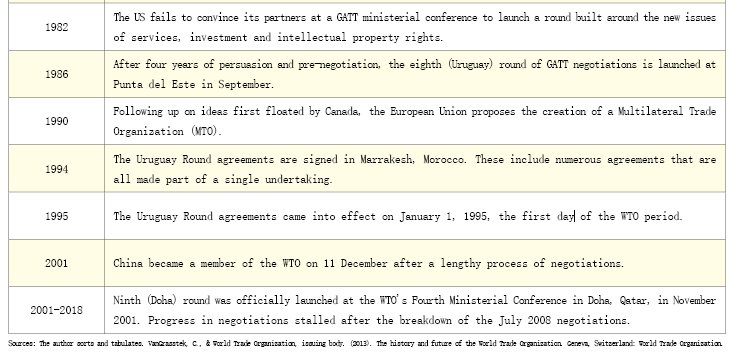Dealing with Trade Negotiations
In an impassioned speech in October,International Monetary Fund Managing Director Christine Lagarde called for a de-escalation of trade tensions and reform of the global trade system. In her speech entitled "New Economic Landscape,New Multilateralism" she told the annual meeting of the IMF and the World Bank that trade cooperation has driven unprecedented growth and prosperity over the last 70-plus years,but today it faces a backlash. She estimated that an escalation of current trade tensions could reduce global GDP by almost one percent over the next two years. Reform of the global trade system should be aimed at making it even better,fairer,and stronger for all nations and all people. "That means fixing the system,together,not tearing it apart," she concluded.
At the same meeting,the IMF released its latest World Economic Outlook report which projects that global growth will be 3.7% in 2018 and 2019,0.2 percentage point lower than the April forecast for both years. Mechanisms for multilateral global policy cooperation,notably trade,are under strain and in need of strengthening. Amid the trade uncertainties,financial conditions are tightening. Rising trade tensions and policy uncertainties are leading to heightened concerns about global economic prospects. These factors could convince firms to postpone or forgo capital spending. That in turn could slow the expansion of investment and demand and weaken growth in trade and industrial output. Escalating trade tensions and a potential shift away from a multilateral,rules-based trading system are key threats to the global outlook. This could "dent business and financial market sentiment,trigger financial market volatility,and slow investment and trade," the IMF said. An increase in trade barriers would also disrupt global supply chains. Recent data from the IMF have shown signs of slowing global trade,manufacturing and investment.
Rules-based global governance structures are facing unprecedented challenges. It is not an exaggeration to say that the global trading system is in danger of entering a "Warring States" era. In order to maintain and expand the benefits of trade integration over the next few decades,countries must cooperate to resolve differences as much as possible without increasing distortionary trade barriers. Otherwise,the bitter fruit of declining global productivity and welfare will be tasted by all.
Fixing the Multilateral Trade System
In 2013,Craig VanGrasstek,an adjunct lecturer in public policy at Harvard University and an experienced trade consultant,wrote a book entitled "The History and Future of the World Trade Organization". It's a very popular work that is considered to be the official "biography" of the WTO. In the last chapter of the book,he raises an imaginative question about the organization that has been in operation since 1948: What about the WTO in 2048? There are many challenges,including how to conclude the Doha negotiations,how to deal with the relationship between the multilateral trading system and Regional Trade Agreements,or RTAs,whether sovereignty issues can be better balanced,and how to reform the WTO to make it play a more effective role. However,he is very optimistic that the WTO has so far proven adaptable,flexible and capable of absorbing the diverse perspectives and ideas of its members. Therefore,there are good reasons to believe that the WTO will still exist in 2048 and beyond.
But what might have surprised Dr. VanGrasstek is that after only five years of making the above predictions,the WTO has experienced a crisis of survival. The main manifestations are as follows: First,the above-mentioned problems existing in the WTO itself have not been effectively resolved,and the organization's authority has been significantly weakened. Second,trade frictions have intensified. Some important members have ignored WTO rules,imposed unilateral tariffs and even threatened to withdraw from the organization itself. That has endangered the organization and threatened loss of control over world trade. Bilateral,multilateral and regional trade negotiations have become a center of attention,and the WTO has become increasingly marginalized.
The underlying cause is Washington's significant dissatisfaction with the WTO. One of its complaints is that the WTO does not do enough in terms of disclosure and punishment because of distorted trade behavior caused by government subsidies and insufficient intellectual property protection. Another is the inequality of the rules,giving developing countries too much flexibility and placing too many constraints on developed countries. The U.S. also contends that its sovereignty has been weakened,accusing the WTO Appellate Body of overstepping judicial borders. It insists this has bound its hands and feet in protecting its own companies,and this limits its ability to deal with unfair foreign competition. Moreover,it insists the organization's response to new challenges such as e-commerce has been sluggish.
Under these pressures,reforming the WTO has gradually become a focus. In late June this year,the European Commission proposed a WTO modernization in an effort to strengthen the global body's negotiating function and promote an updating of its rules. The discussion of the plight of the Appellate Body occupied one-third of the report,much to the chagrin of the United States. In July,Canada issued a proposal to strengthen and reform the WTO,including in the areas of e-commerce,investment protection and boosting trade with developing countries. On September 25,the United States,Japan and the EU's tripartite trade ministers' meeting issued a joint statement,arguing that in the WTO reform,the definition of developing countries should be examined and their more advanced members should be required to assume full obligations. Digital trade and e-commerce were also a focus of attention. On September 30,the International Monetary Fund,the World Bank and the WTO issued a joint report on trade issues,recommending that the WTO change the manner in which negotiations are conducted,speed up the negotiation process,and reduce the use of "single undertaking"- or the principle of treating every item as part of a whole package and not something to be agreed on separately. At the same time,we attach importance to limited multilateral negotiations. On October 24-25,Canada invited 12 WTO members to study the reforms.
The history of multilateral trade negotiations has had its twists and turns. (see Table 1) At times the process has been frustratingly slow. As 2018 draws to a close,the Doha Round,officially launched at the WTO's Fourth Ministerial Conference in November 2001,has an uncertain future. My view is that the WTO Doha negotiations are effectively dead,thanks to the impossible hurdles of the principle of consensus and the rule of single undertaking. The changed situation of developing countries and developed ones as compared to the start of the Doha round in 2001 also needs to be addressed.


But the first priority is to ensure that the WTO's dispute settlement mechanism can play its intended role,otherwise the WTO will be paralyzed. Normally,the number of members of the Appellate Body is seven. As of the end of September 2018,there were only three people ¨C the minimum number to hear an appeal. The Trump administration has been obstructing the appointment of new candidates. On December 10,2019,the terms of two of those members expire,and the WTO dispute settlement mechanism will be suspended. As Alan Wolff,the deputy director-general of the WTO,has said,without the WTO Appeals Tribunal,every dispute could evolve into a trade war. Therefore,the appointment process for new members must be restored as soon as possible.
In addition,other critical problems include the responsibilities of advanced developing members,state-owned enterprises,industrial subsidies,market access,technology transfers,intellectual property protection,and competition policies. These will be the key to future WTO reforms and negotiations.
The WTO can only survive after being reformed. However,there is little time left. Active planning and participation in WTO reforms while strengthening the negotiation process for RTAs is more important than ever.
Strengthening RTA Negotiations
The most fundamental of the founding principles of GATT/WTO is the "most favored nation" principle,which states that all members should be treated equally. This non-discrimination principle is at the core of the WTO. Members have committed,in general,not to favor one trading partner over another. If one member reduces its tariffs on goods coming from another member,it must do the same for those goods coming from any other member. Such tariff reductions are called multilateral.
Regional trade agreements (RTAs) are often an exception to this rule,as a group of members may decide to completely eliminate all tariffs among them,without eliminating tariffs on goods coming from the rest of the world. These deals,by their very nature,are discriminatory as only their signatories enjoy more favorable market-access conditions,since the members involved are treated differently from those outside the group. WTO members recognize the legitimate role of RTAs which aim at facilitating trade within these special groupings but do not raise trade barriers vis-à-vis third-parties.
But such agreements are permitted under Article XXIV of the GATT,provided that "the duties [with outside parties] shall not on the whole be higher or more restrictive than the general incidence of the duties ... prior to the formation." RTAs must cover substantially all trade - unless they are under the Enabling Clause ¨C a legal basis for exceptions ¨C which allows and helps trade flow more freely among the countries in the RTA without raising barriers to trade with the outside world.
Numerous studies have been conducted on whether countries inside an RTA are generally better or worse off. So far there is no definitive answer. (Feenstra,R. (2016). Advanced international trade : Theory and evidence (Second ed.). Princeton: Princeton University Press.) But with the multilateral option apparently on hold,it is quite natural that WTO members look to alternative ways to negotiate,and a country's global trade status seems more dependent on the signing of RTAs.
According to the WTO,RTAs are taken to mean any reciprocal trade agreement between two or more partners,not necessarily belonging to the same region. As of June 2016,all WTO members had an RTA in force. Over the years,RTAs have not only increased in number but also in depth and complexity (see Figure 1).
In the first book to provide a fully comprehensive overview of the complicated issues facing multinational companies and their global sourcing strategies,Pol Antràs,a professor at Harvard University,wrote that the majority of international trade transactions today are dominated by sales of individual components and intermediary services,only few of them are based on the exchange of finished goods. Many firms now organize production on a global scale and offshore parts,components,and services to producers in distant countries,and in response to the perceived contractual insecurity,the spend a substantial amount of time and resources figuring out the best possible way to organize global production. ( Antràs,P. (2016). Global production : Firms,contracts,and trade structure (CREI lectures in macroeconomics). Princeton ; Oxford: Princeton University Press.) Because 70% of international trade now is for production in global value chains (GVCs),a report by OECD suggests that trade agreements should cover as many dimensions of GVCs as possible. (OECD,"Trade policy implications of global value chains", December 2018. See http://www.oecd.org/tad/trade-policy-implicat

